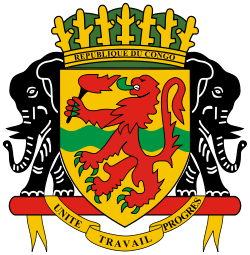Politics of the Republic of the Congo
 |
| This article is part of a series on the politics and government of the Republic of the Congo |
|
Politics of the Republic of the Congo takes place in a framework of a presidential republic, whereby the President is both head of state and head of government, and of a pluriform multi-party system. However, following the approval of a new Constitution in a 2015 referendum, Congo will become a semi-presidential republic with a Prime Minister. Legislative power is vested in both the government and the two chambers of the parliament.
Executive branch
| Office | Name | Party | Since |
|---|---|---|---|
| President | Denis Sassou-Nguesso | Labour Party | 25 October 1997 |
Legislative branch
The Parliament (Parlement) has two chambers. The National Assembly (Assemblée Nationale) elects its members to five-year terms in single-seat constituencies. The members of the Senate (Sénat) are elected for a six-year term by district, local and regional councils. The Republic of Congo is a one party dominant state with the Congolese Labour Party in power. Opposition parties are allowed, but are widely considered to have no real chance of gaining power.
Political parties and elections
| Candidates - Parties | % |
|---|---|
| Denis Sassou-Nguesso - Congolese Labour Party (Parti Congolais du Travail)/United Democratic Forces (Forces Démocratiques Unies) | 89.4 |
| Kignomba Kia Mbougou - Pan-African Union for Social-Democracy (Union Panafricaine pour la Démocratie Sociale) | 2.8 |
| Angèle Bandou - Party of the Poor (Parti des Pauvres) | 2.3 |
| Jean Félix Demba Telo | 1.7 |
| Luc Adamo Mateta - Convention for Democracy and Salvation (Convention pour la Démocratie et le Salut) | 1.6 |
| Come Mankasse - Congolese Union of Republicans (Union Congolais des Républicains) | 1.3 |
| Bonaventure Mizidy - Republican and Liberal Party (Parti Républicain et Liberal) | 1.0 |
| Total (turnout 74.7 %) | 100.0 |
| Source: Supreme Court of the Republic of Congo | |
| Parties | Seats (1st round) |
Seats (2nd round) |
Total seats |
|---|---|---|---|
| Congolese Party of Labour (Parti Congolais du Travail) | 22 | 25 | 47 |
| Independents | 8 | 29 | 37 |
| Congolese Movement for Democracy and Integral Development (Mouvement Congolais pour la Démocratie et le Développement Intégral) | 4 | 7 | 11 |
| Pan-African Union for Social Democracy (Union Panafricaine pour la Démocratie Sociale) | 3 | 8 | 11 |
| Action Movement for Renewal (Mouvement Action Renouveau) | 3 | 2 | 5 |
| Movement for Solidarity and Development (Mouvement pour la Solidarité et le Développement) | 1 | 2 | 3 |
| Club 2002 | 1 | 2 | 3 |
| Take Action for Congo (AGIR pour le Congo) | 1 | 2 | 3 |
| New Democratic Forces (Forces Démocratiques Nouvelles) | 0 | 3 | 3 |
| Patriotic Union for Democracy and Progress (Union Patriotique pour la Démocratie et le Progrès) | 0 | 2 | 2 |
| Rally for Democracy and Social Progress (Rassemblement pour la Démocratie et le Progrès Social) | 0 | 2 | 2 |
| Union for the Republic (Union pour la République) | 0 | 2 | 2 |
| Union for Progress (Union pour le Progrès) | 0 | 2 | 2 |
| Union for Democracy and the Republic (Union pour la Démocratie et la République) | 0 | 1 | 1 |
| Union of Democratic Forces (Union des Forces Démocratiques) | 0 | 1 | 1 |
| Movement for Democracy and Progess (Mouvement pour la Démocratie et le Progrès) | 0 | 1 | 1 |
| Youth in Movement (Jeunesse en Mouvement) | 0 | 1 | 1 |
| Citizen Rally (Rassemblement Citoyen) | 0 | 1 | 1 |
| The Life Party (Parti la Vie) | 0 | 1 | 1 |
| Total | 43 | 94 | 137 |
| Source: Xinhua, Panapress, IPU, E-polytika, AngolaPress, Congopage | |||
International organization participation
ACCT, ACP, AfDB, BDEAC, CCC, CEEAC, ECA, FAO, FZ, G-77, IBRD, ICAO, ICFTU, ICRM, IDA, IFAD, IFC, IFRCS, ILO, IMF, IMO, Intelsat, Interpol, IOC, IOM (observer), ITU, NAM, OAU, OPCW, UDEAC, UN (Security Council member for 2006/2007), UNCTAD, UNESCO, UNIDO, UPU, WFTU, WHO, WIPO, WMO, WToO, WTrO